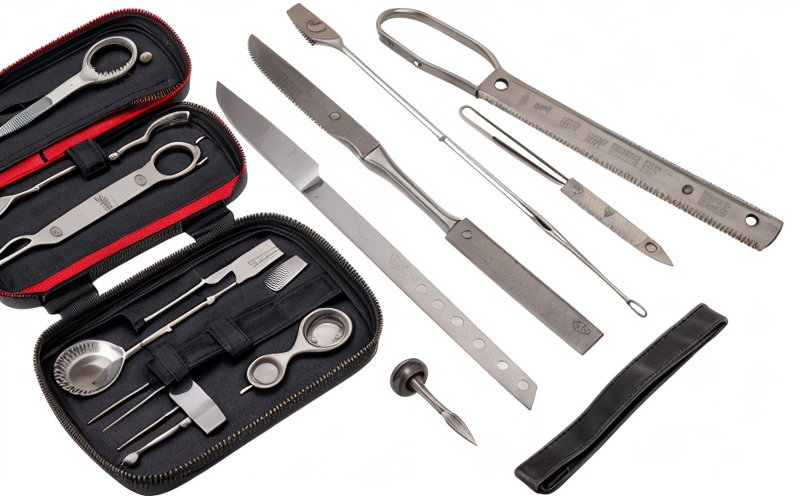Real Time Shelf Life Stability Testing of Instruments
The shelf life stability testing is a critical step in ensuring that surgical instruments and tools maintain their integrity and functionality throughout their intended use. This process involves exposing the instruments to various environmental conditions, including temperature, humidity, and storage time, to assess how these factors affect instrument performance over time.
For medical devices, especially surgical instruments such as scalpels, forceps, clamps, retractors, and other tools used in minimally invasive procedures, it is essential that the instruments remain sterile and functional. Shelf life stability testing helps manufacturers ensure compliance with stringent regulatory requirements set by bodies like the FDA and ISO standards.
The testing process typically involves placing a sample of surgical instruments in an environmental chamber designed to simulate real-world storage conditions. The chamber can be programmed to replicate different temperatures (e.g., 23°C, 40°C) and humidity levels (e.g., 50%, 75%), which are common storage scenarios for medical devices.
During the test, the instruments undergo regular inspections using a variety of analytical methods. These include:
- Mechanical testing to assess changes in instrument geometry after exposure
- Bacteriological testing to ensure sterility is maintained during storage
- Visual inspections for any signs of corrosion or degradation
- Electrical conductivity tests if the instruments are electrical devices
The test duration can vary depending on the specific instrument and regulatory requirements. For instance, according to ISO 17652-4:2019, which specifies the shelf-life testing of surgical instruments, the exposure time in a real-time stability test is generally six months.
Once the testing period has concluded, the laboratory analyzes all data collected during the experiment. The results are then reported according to industry standards and guidelines. This report serves as evidence that the instrument meets safety and performance requirements throughout its shelf life.
A well-executed real-time stability test is crucial for several reasons:
- It helps manufacturers comply with regulatory mandates.
- It ensures patient safety by guaranteeing that instruments remain effective even after extended storage periods.
- It reduces the risk of recalls and product liability issues.
The testing process also aids in optimizing packaging design, ensuring that instruments can be stored safely without compromising their quality. By understanding how different environmental conditions affect instrument performance, manufacturers can make informed decisions about package materials and storage instructions.
In summary, real-time shelf life stability testing is an integral part of the development process for surgical instruments. It ensures that these critical medical devices remain reliable and safe throughout their intended use, thereby enhancing patient outcomes and reducing healthcare costs associated with ineffective or unsafe equipment.
Benefits
The benefits of conducting real-time shelf life stability testing are numerous and far-reaching:
Regulatory Compliance: Ensures adherence to FDA, ISO, EN, IEC, and other relevant standards. This helps avoid potential penalties and legal issues.
Patient Safety: Guarantees that surgical instruments remain sterile and functional throughout their shelf life, minimizing risks during procedures.
Risk Management: Identifies potential quality issues early in the development process, reducing the risk of product recalls and associated costs.
Economic Efficiency: Optimizes packaging design to ensure maximum protection without unnecessary expenses. It also helps in estimating accurate inventory levels based on expected usage rates.
Innovation Support: Provides valuable data that can be used to improve instrument designs, materials, and manufacturing processes.
Quality and Reliability Assurance
Bacteriological Testing: Ensures the instruments remain sterile throughout storage by conducting bacteriological tests. This is crucial for surgical tools that are in direct contact with patients' tissues.
Mechanical Testing: Evaluates any changes in instrument geometry or functionality after exposure to various environmental conditions. This helps assess whether the instruments can still perform their intended functions accurately and safely.
Visual Inspection: Checks for signs of corrosion, rust, or other forms of degradation that could affect the integrity of the instrument. Visual inspections are critical in identifying potential issues early before they become serious problems.
Electrical Conductivity Tests: Performed on electrical surgical instruments to ensure that any changes in conductivity do not compromise safety or effectiveness during use.
All these tests contribute to maintaining high-quality standards and ensuring reliability of the tested surgical instruments. The combination of these methods ensures comprehensive evaluation, providing robust evidence for compliance with regulatory requirements and enhancing overall product quality.
Competitive Advantage and Market Impact
Conducting rigorous real-time shelf life stability testing offers several competitive advantages:
Enhanced Reputation: Demonstrating adherence to strict quality control measures enhances the reputation of both manufacturers and their products. Hospitals, clinics, and other healthcare providers are more likely to trust and choose suppliers who prioritize quality.
Innovation Leadership: Continuous improvement through thorough testing fosters a culture of innovation within the company. By staying ahead in terms of product reliability and safety, companies can introduce new features or improvements based on tested data.
Better Customer Relationships: Reliable products build strong customer relationships. Healthcare providers appreciate suppliers who consistently deliver high-quality instruments that meet all necessary standards.
Market Expansion: Compliance with international regulations opens doors to global markets. Countries around the world have different regulatory requirements, but meeting these ensures broader market reach and increased sales potential.
In conclusion, real-time shelf life stability testing is not just a compliance exercise; it's an essential tool for maintaining high standards of quality and reliability in surgical instruments. By investing in such thorough testing processes, manufacturers can secure their competitive edge and contribute positively to the healthcare industry.





